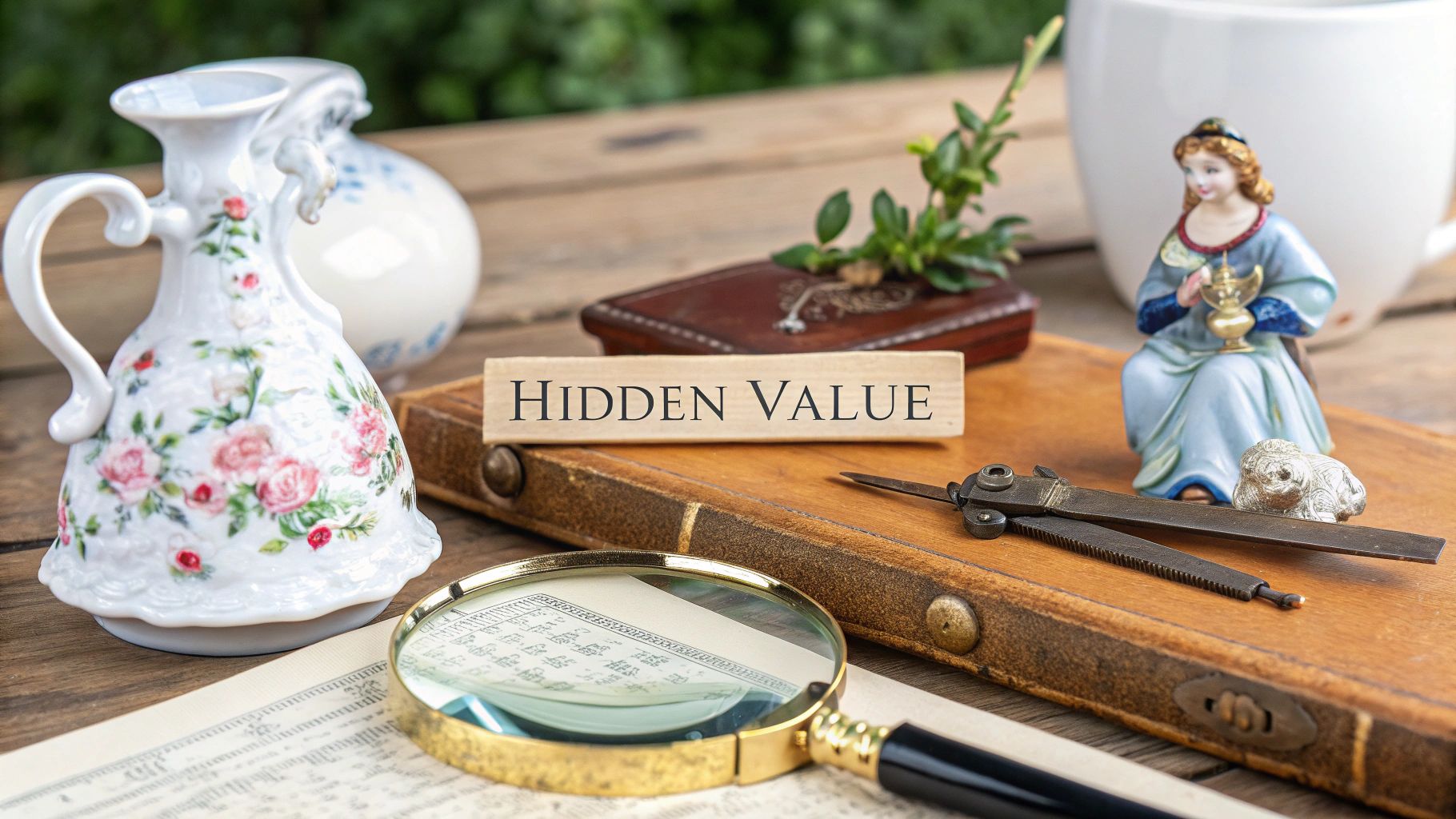Think of an antique appraisal as your roadmap to uncovering an item's true story and what it's worth in today's market. It all starts with a good, hard look at the object itself. The goal is to carefully examine it for every little detail—what it's made of, how it was put together, and its current condition. Learning to spot subtle clues, like a hidden maker's mark or a unique design feature, is how you'll gather the evidence needed for a solid valuation.
Your First Steps in Antique Appraisal
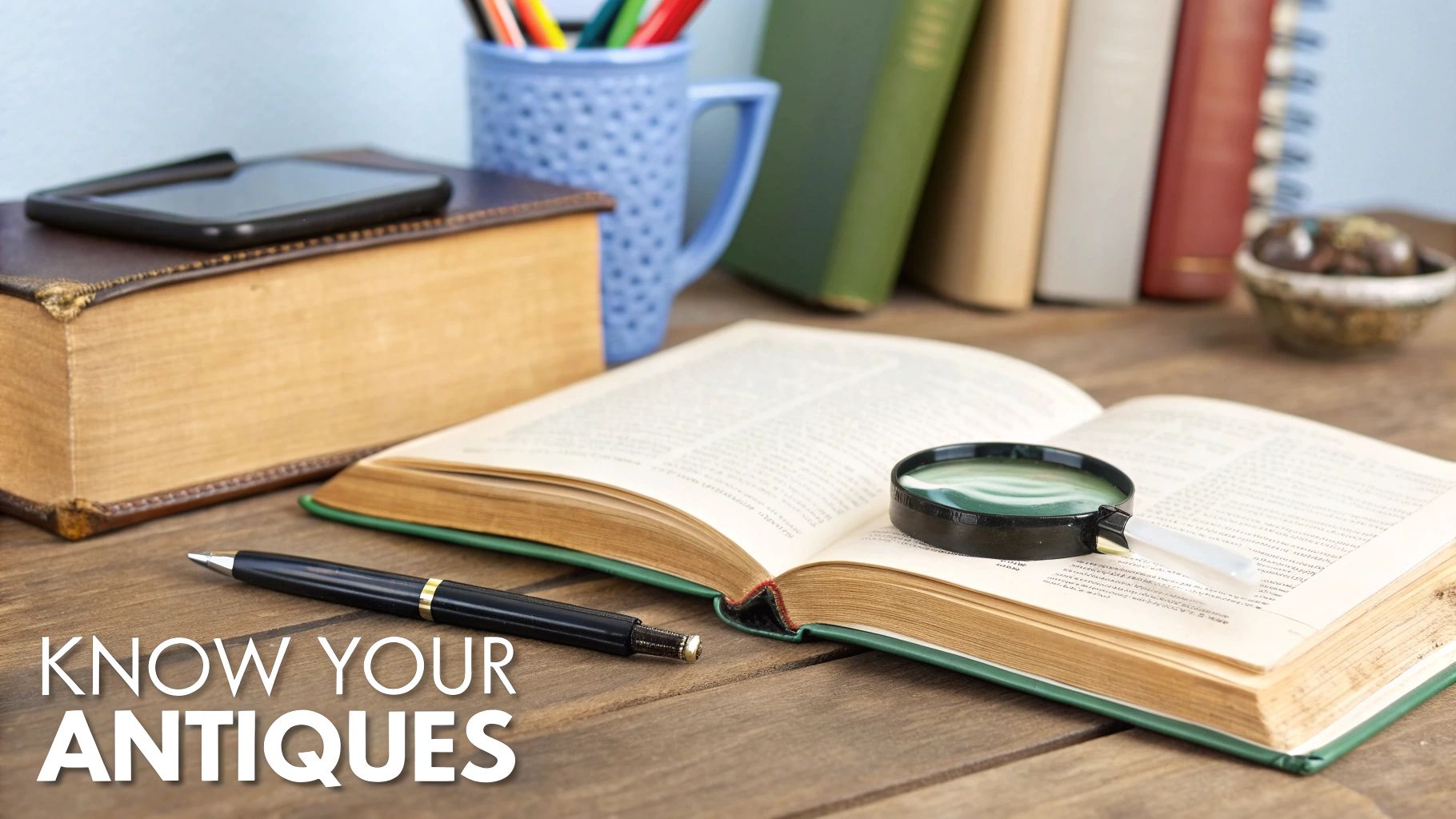
Before you even think about looking up prices or checking auction results, you have to play detective. The journey of any good appraisal doesn't start with a dollar sign; it begins with the story told by the object's physical evidence. Your main job is to "read" the piece in your hands, gathering every clue that points to its origin, age, and journey through time.
This initial once-over is the bedrock of your entire valuation. I've seen it time and again—people rush this part and end up with a wildly inaccurate conclusion. You have to put on two hats: one of a historian and one of a materials expert, looking past the surface to really understand the piece.
Handling with Care
The first rule in the world of antiques is simple: do no harm. Many old items are much more delicate than they look. Before you even touch the piece, make sure your workspace is clean, stable, and has plenty of light.
- A Gentle Touch: Always handle items with clean hands. Better yet, wear soft cotton gloves to keep your skin's oils from damaging the surface.
- Support the Base: When lifting things like ceramics or glass, support them from the bottom. Never pick them up by their handles, rims, or other decorative bits—those are usually the weakest points.
- Safe Placement: Set the item down on a soft, non-scratchy surface like a felt cloth or a folded towel. This helps prevent accidental scratches and chips.
Before you start your detailed inspection, it’s a good idea to run through a quick checklist. This ensures you're looking at the item from all angles and not missing any of the foundational clues.
Initial Antique Assessment Checklist
| Assessment Area | What to Look For | Why It Matters |
|---|---|---|
| Maker's Marks | Stamps, signatures, symbols, logos, or serial numbers. Check the bottom, back, and inside. | This is the most direct way to identify the manufacturer, country of origin, and sometimes the exact production date. |
| Materials | Type of wood, metal, ceramic, glass, or fabric. Is it solid wood or veneer? Porcelain or earthenware? | Materials are a huge clue for age and origin. For example, the use of certain plastics can date an item to a specific decade. |
| Construction | Hand-cut vs. machine-cut joints, hand-stitched vs. machine-sewn seams, screws, nails, or adhesives. | How an item was made reveals the technology of its time, helping you narrow down the period it was created. |
| Condition | Chips, cracks, repairs, fading, stains, wear and tear (patina), or missing parts. | Condition has a massive impact on value. Original, untouched condition is often prized, but a good repair can be better than severe damage. |
| Overall Style | Design elements, shape, color, and decorative motifs (e.g., Art Deco, Victorian, Mid-Century Modern). | The style helps place the item within a specific design movement and historical period, which affects its desirability. |
This checklist is your starting point. As you get more experienced, this process will become second nature, allowing you to quickly size up an item's potential.
The Art of Observation
Now for the real work. Your eyes are your best tool. A methodical approach is key, so you don't overlook a tiny detail that could completely change the item's value. I always start with a general look and then zoom in on the specifics.
Hunt for identifying marks—they're the most helpful clue you can find. These might be stamps, signatures, or little symbols etched into the material, often hidden on the bottom, back, or even inside a drawer. A good magnifying glass or a jeweler's loupe is a must-have for reading marks that are small or have worn down over time.
Expert Tip: Don't just look for a well-known company name. Sometimes, a simple set of initials, a small symbol like an anchor or a crown, or a string of numbers can tell you everything you need to know about the maker and even the year it was made.
Next, get a feel for the materials and construction. How was it put together? Is that antique dresser joined with hand-cut dovetails or machine-cut ones? Is that plate a heavy, dense piece of ironstone, or is it fine and translucent like porcelain? These details are absolutely critical for dating an item and figuring out where it came from.
Understanding Market Dynamics
As you gather these clues, it helps to have a sense of the market you're dealing with. The global antiques market is a massive, ever-changing beast. In fact, antiques generated USD 58.4 billion in revenue in 2024 and are on a path of steady growth.
What's really interesting is that a huge chunk of this market—about 49% in 2024—is driven by items in the mid-price range, between USD 50 and USD 500. This shows that there's a strong appetite for pieces that are accessible yet unique. You can find more market analysis in this GlobeNewswire report on the second-hand collectibles market.
This data proves that you don't need a museum-quality masterpiece to have something valuable. By giving your item a thorough initial inspection, you're taking the most important step toward accurately placing it within this bustling marketplace. Every detail you uncover helps build the case for its final appraisal.
How to Research Your Antique Like a Pro
Alright, you've given your antique a thorough once-over and have a handful of clues. Now for the fun part: the detective work. This is where you connect the dots, turning those physical details into a story about where your piece came from, how old it is, and whether it's the real deal.
Think of it like being a historian. That little maker's mark you found is a fantastic starting point, but it's just one piece of the puzzle. Without the context from historical records, auction sales, and expert knowledge, it's just a symbol. This research phase is what separates a wild guess from a confident appraisal.
Mastering Your Search Strategy
Firing up Google is usually the first instinct, but just typing "old brown chair" into the search bar is a fast track to nowhere. The trick is to use the specific details you've already gathered to build a much smarter search.
For example, instead of that generic search, try something far more descriptive, like "Chippendale style chair ball and claw feet mahogany." See how each term acts as a filter? It weeds out the noise and gets you closer to a match. If you were lucky enough to find a maker's mark, that becomes your golden ticket.
- Be Specific with Marks: Don't just search for "plate with anchor on bottom." Get precise. A search for "Davenport ironstone anchor mark" will give you much cleaner, more relevant results.
- Use Descriptive Adjectives: Always include materials, colors, and styles. Think "Art Deco chrome lamp" or "Victorian walnut settee."
- Include Construction Details: Add terms that speak to how the item was made, like "dovetail joints" or "hand-painted," to narrow your search even further.
This whole process is a loop. Each new piece of information you uncover should be folded back into your search, painting a clearer picture with every click. If you're hitting a wall trying to figure out a particular mark or style, our guide on how to identify antiques can help you sharpen those foundational skills.
Tapping Into Expert Resources
Once you've exhausted a general web search, it's time to dig into the same resources the pros use. These online databases and archives are the modern equivalent of spending hours in a dusty library, and they are absolutely essential for verifying what you've found.
A fantastic place to start is with online museum collections. Major institutions like the Victoria and Albert Museum or the Metropolitan Museum of Art have put huge parts of their collections online. You can search their databases for pieces similar to yours, which is a great way to confirm a time period, a particular style, or even a specific maker.
Expert Insight: Don't get hung up on finding an exact twin of your item. Look at other pieces from the same maker or era to get a feel for their design language. When you see ten other vases by the same potter, you start to recognize their signature glaze or form.
Here are a few other powerhouse resources:
- Auction Result Databases: Websites that log past auction sales are a goldmine. They show you what similar items actually sold for, giving you hard data on market value.
- Specialized Forums: From military medals to vintage toys, there's an online community for just about every collectible imaginable. Post clear photos and your findings—you might just get some free advice from a seasoned expert.
- Digital Libraries and Archives: Sites like the Internet Archive are treasure troves of old trade catalogs, magazines, and books that can help you place an item in time or identify a specific pattern.
The Critical Importance of Provenance
One of the most powerful, and often overlooked, factors in an antique's value is its provenance—the documented history of who has owned it. A solid, unbroken chain of ownership can send an item's value soaring because it proves authenticity and adds a compelling historical story.
Provenance isn't just for priceless museum artifacts. It might be as simple as an old sales receipt you find tucked in a drawer, a letter mentioning the piece, or even an old family photo with the item in the background. Think about it: a standard Civil War-era pocket watch is interesting. But that same watch, accompanied by a letter from the soldier who carried it at the Battle of Gettysburg? That's a piece of history.
Start by tracing the history you already know. Ask older family members for any stories or papers related to the item. Check the backs of furniture or paintings for old gallery labels, inscriptions, or stickers. Every scrap of paper adds another link to the chain, building a stronger case for your antique's value and historical significance.
Determining an Antique's Market Value
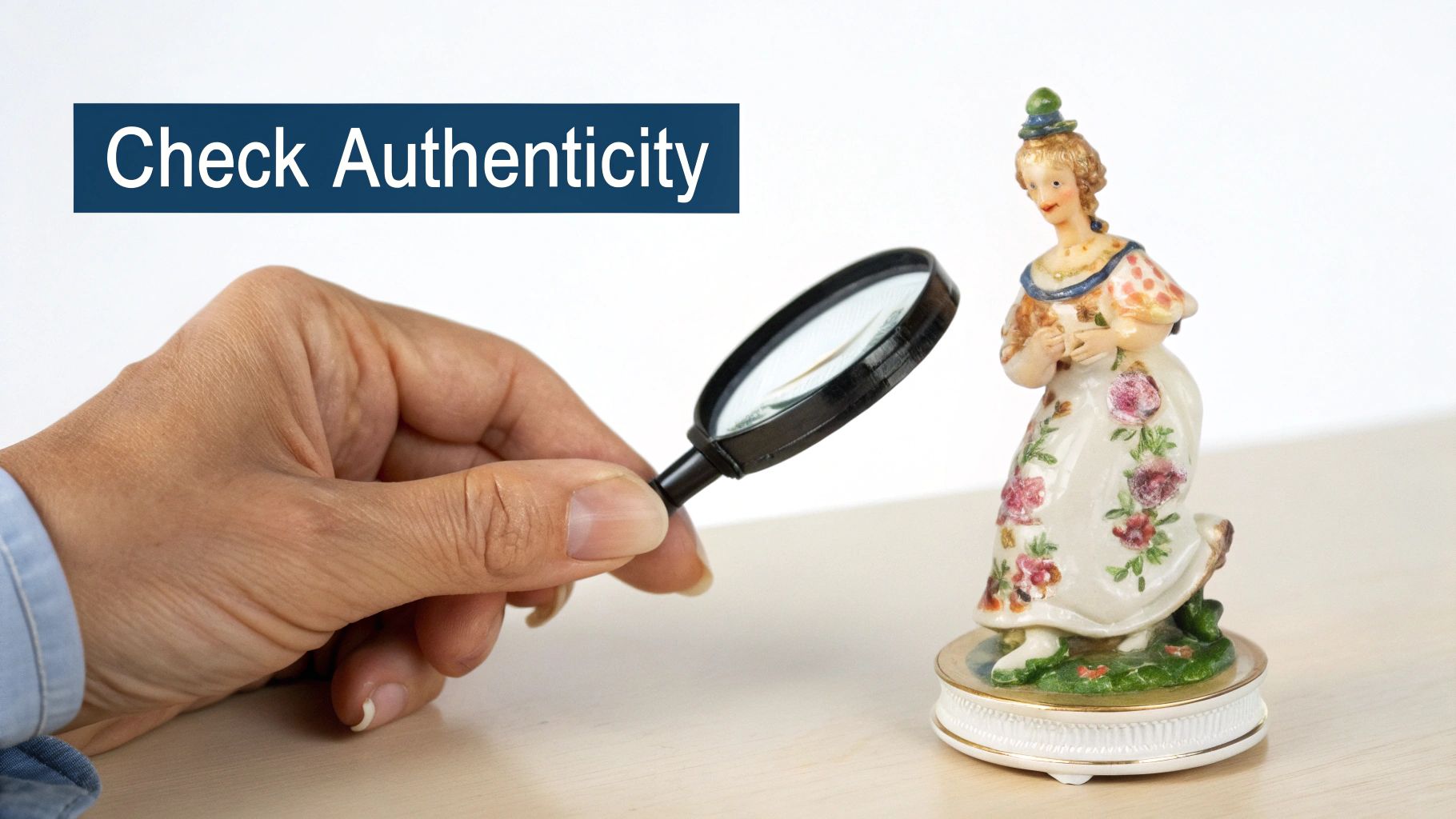
After all the historical research and detective work, it’s time to talk money. What is your antique actually worth today? An item's history is fascinating, but its market value is a completely different beast, driven by the real-world forces of supply and demand. This part of the process is all about connecting an object's past to its present-day price tag.
It's a crucial distinction to make. I've seen pieces with a rich, well-documented history that have very little monetary value simply because no one is looking for them right now. On the flip side, a seemingly ordinary item can fetch a surprisingly high price if it happens to be trendy. The key is to learn how to read the market as skillfully as you read an item's maker's marks.
The Four Pillars of Value
The value of any antique isn't a fixed number; it's a dynamic figure that rests on four main pillars. If one is shaky, the whole valuation can come tumbling down.
- Rarity: How many of these are still out there? A one-of-a-kind piece or something from a tiny production run will naturally be more sought-after than a mass-produced object.
- Condition: Is the item in pristine, original shape, or does it have chips, cracks, or old repairs? A little bit of honest wear, or patina, can be desirable, but significant damage almost always drags the value down.
- Demand: Are collectors actually searching for this style, maker, or period at this moment? Tastes change, and what was hot a decade ago might be collecting dust today.
- Provenance: As we touched on earlier, a documented history of ownership adds a layer of authenticity and a compelling story that can seriously boost an item's appeal and price.
These elements all work together. A rare item in poor condition might be worth less than a more common piece in mint condition. Your job is to weigh these factors to land on a realistic valuation.
Finding Your "Comps"
The most reliable way to figure out what an antique is worth is to find "comparables," or "comps." These are documented sale prices for items that are as close a match to yours as possible. This isn't about what a dealer is asking online; it's about what a real buyer has actually paid.
Auction house records are the gold standard here. Many major auction houses have searchable online databases of past sales, giving you hard data on realized prices. Online marketplaces with "sold listings" filters are also fantastic tools for seeing what similar pieces have recently fetched.
When looking for comps, be brutally honest. A tiny difference in condition, size, or maker can create a huge gap in price. For example, a common Johnson Bros. ironstone platter from the 1970s might sell for $20-25. But a much rarer T&R Boote ironstone tureen from the 1860s in perfect condition could easily be valued at $65-85.
Pro Tip: Don't just look at one or two comps. Try to find a handful of recent sales to establish a clear price range. This helps you account for outliers and get a much more accurate picture of the true market value.
Taking the Market's Pulse
The antiques market isn't static. It's constantly influenced by economic trends and shifting collector tastes. A strong economy often means more disposable income for collecting, while a downturn can cool prices across the board.
We see this reflected in recent data. In 2024, combined global sales of art and antiques reached USD 57.5 billion. What’s interesting is that while total revenue dipped slightly, the number of transactions actually grew by 3%. A full 85% of dealer sales came from items priced under USD 50,000, which tells me there's a very active market at lower and mid-range price points, even if the super high-end has softened.
To really get a feel for an item’s potential, it helps to look at valuation principles as a whole. For a great overview, check out these expert tips on valuing old coins—you'll find that many of the same rules apply to all sorts of collectibles.
For more focused guidance, you might be interested in our dedicated guide: https://www.curio.app/blog/your-essential-antique-pricing-guide. By combining solid research on comparables with a good sense of current market trends, you can move from a simple historical appreciation to a confident, evidence-based valuation.
Using Modern Tools for Smarter Appraisals
Technology has really changed the game for anyone trying to figure out what an antique is and what it's worth. I remember spending countless hours poring over dusty reference books in the library. Now, the smartphone in my pocket can do a lot of that initial legwork in just a few seconds. These modern tools are like having a research assistant on call, helping you sharpen your eye and your valuations.
The biggest breakthrough, without a doubt, is AI-powered image recognition. I’ve found apps like Curio to be incredibly helpful for getting a quick read on something unfamiliar. You just snap a photo, and the app scans the internet for visually similar items, often giving you a name, potential origin, and historical context. It's a fantastic way to turn a complete mystery into a known object.
This initial ID gives you the crucial keywords—a maker's name, a style, a time period—that you need to start digging deeper. It’s the perfect launchpad for any appraisal.
How to Weave Tech into Your Appraisal Process
It's important to think of these tools as a starting point, not the final answer. Their real strength is in cutting down that initial research time. Once an app points you in the right direction, you can take that lead and run with it, heading to specialized databases, auction records, and museum archives to confirm the details.
For example, an app might identify a ceramic plate as "English ironstone." That’s a great clue. You can then use that to look up specific makers known for ironstone, like Johnson Bros. or John Maddock & Sons. From there, you're comparing your plate’s specific maker's mark and pattern to online guides to nail down its exact origin and age. A common Johnson Bros. "Heritage" platter from the 1970s might sell for $20-25, but a much rarer T.J. & J. Mayers platter from the 1870s could command a very different price.
Here’s a great example of what Curio can do, turning a simple picture into a real starting point for your research.
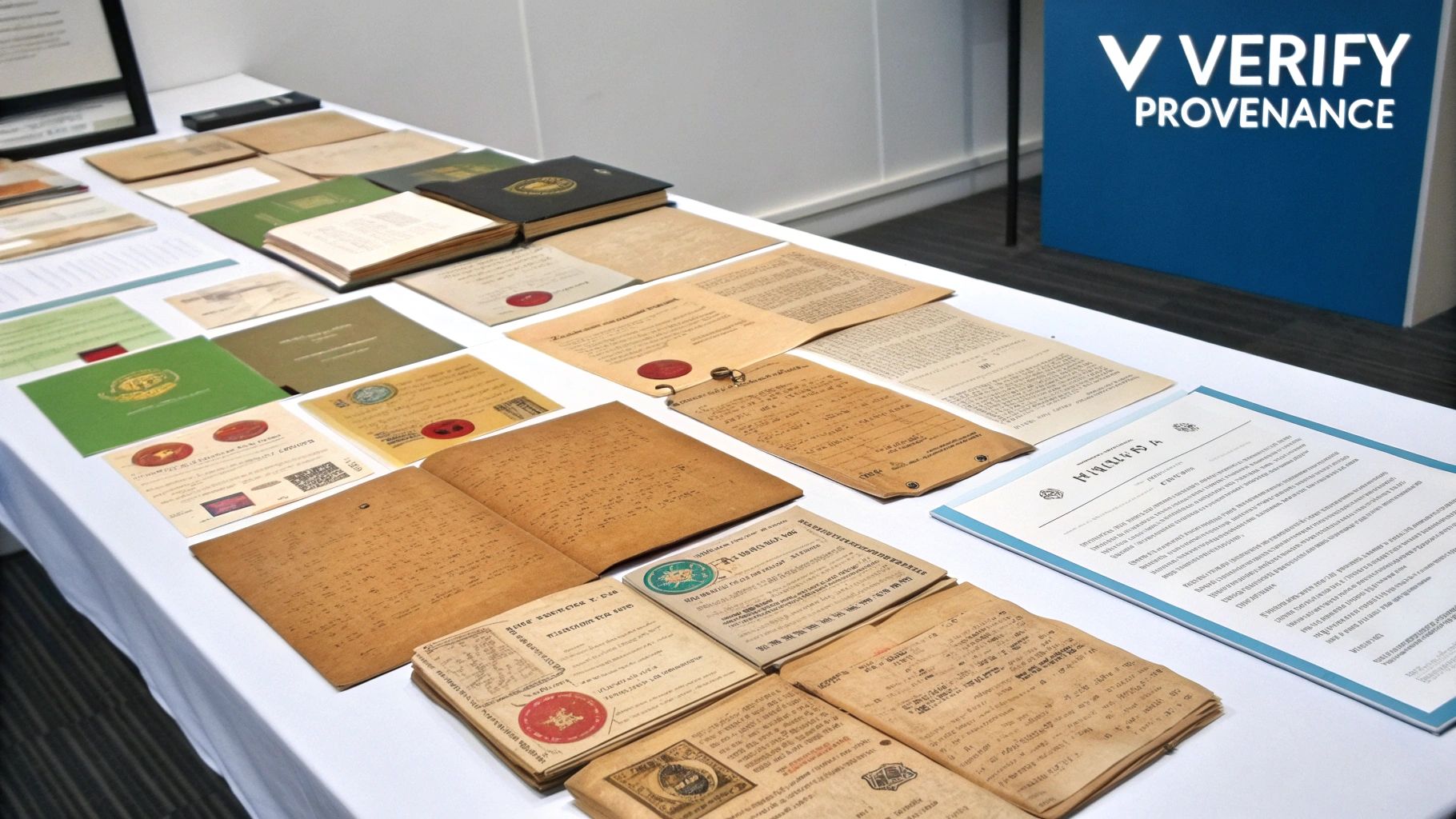
As you can see, the app doesn't just find a match. It gives you a title, a detailed description, some historical background, and an estimated value range—all from one photo.
It’s Not Just About Taking Pictures
The modern appraiser's toolkit goes well beyond just identifying things with a camera. New tech is helping us solve some of the oldest problems in the antiques world.
- Reading Faded Text: Have you ever squinted at a faded, handwritten signature on a painting or a label on the bottom of a vase? Digital enhancement tools can sharpen that text, revealing crucial names or dates that were otherwise lost to time.
- Analyzing Materials: This one is still more for the pros, but portable X-ray fluorescence (XRF) analyzers are becoming more common. These gadgets can tell you the exact metals in a piece of jewelry or the pigments in a ceramic glaze without causing any damage. It's an incredible way to confirm an item's materials and spot sophisticated fakes.
- Locking Down Provenance: Blockchain is starting to be used to create a secure, unchangeable digital record of an item’s ownership history. This creates a transparent "chain of custody" that can dramatically boost an item's value and a buyer's confidence.
A Quick Word of Caution: It's easy to get carried away with new tools, but remember they are assistants, not substitutes for your own judgment. AI can get it wrong, and online databases aren't always complete. Always double-check the information and, most importantly, trust your own research and what your eyes are telling you.
Ultimately, these tools help you work smarter, not just harder. They take care of the heavy lifting of that initial identification, which frees you up to focus on the more nuanced parts of an appraisal—judging condition, researching the market, and telling the story of the piece. By making these resources a part of your process, you'll be able to put together a far more accurate and confident appraisal for any item that comes your way.
Selling Your Antique in the Right Market
An antique’s value isn't set in stone. It’s a number that can jump—or plummet—based on one simple thing: where you sell it.
Think about it this way. A rare piece of early American folk art might spark a bidding war at a New York City auction but get little more than a polite nod in London. Getting the best price for your piece comes down to understanding these geographic tastes. You need to connect your antique with the collectors who actually want it most, and those people often live in very specific places.
Tapping into Regional Tastes
Collector preferences are almost always tied to cultural history and local pride. This creates "hot spots" where demand for certain antiques is through the roof, and the prices reflect that.
For instance, a stunning piece of French Art Nouveau furniture will almost certainly fetch a higher price in Paris than it would in Dallas. The same goes for Scandinavian mid-century modern design; its most passionate buyers are in places like Copenhagen and Stockholm.
A Real-World Scenario: Let's say you inherited a beautifully carved Black Forest cuckoo clock from Germany. You could probably sell it at a local estate sale in the U.S. for a decent price. But its true market value is waiting in Germany or Switzerland, where collectors have a deep, lifelong appreciation for that specific craft. Taking it to the right market could be the difference between a few hundred dollars and a few thousand.
This idea holds true for just about every category of antique. Figuring out where an item was made is often the first and best clue for finding the people who will pay top dollar for it.
The Global Market Hotspots
The antique market is more connected than ever, but certain regions still drive the major trends. Europe, for example, has always been a powerhouse. In 2023, it held a massive 36.89% of the global collectibles market share. We see things like a rare Fabergé egg selling for USD 9.6 million, which tells you there's an established and very serious collector base for historically important European pieces.
But things are changing. The Asia Pacific region has exploded to become the fastest-growing collectibles market, with experts projecting a 6.4% annual growth rate through 2030. This boom has produced some jaw-dropping results, like a Ming Dynasty vase that sold for an astounding USD 24.5 million. The takeaway here is powerful: if you own an antique of Asian origin, its highest value is likely found by selling it back into that market. You can dig deeper into these trends in this collectibles market report.
Here’s a quick cheat sheet for where different items tend to shine:
- United States: The prime market for American folk art, Native American artifacts, Colonial furniture, and classic Hollywood memorabilia.
- United Kingdom: Strong demand for English silver, Staffordshire pottery, Georgian furniture, and British portraits.
- China: The global center for Chinese ceramics (especially Ming and Qing dynasties), intricate jade carvings, and classical scroll paintings.
- France: The go-to market for Art Deco furniture, Impressionist art, and luxury goods like vintage Hermès.
How to Navigate International Sales
So, you’ve identified the best market. Now what? The logistics of selling overseas might seem intimidating, but it’s more doable than you might think.
Major international auction houses like Sotheby's, Christie's, and Bonhams are a great place to start. They have specialists and offices all over the world. The process often begins with a simple online inquiry where you submit photos and any paperwork you have. If they feel your item is a good fit for one of their sales, they’ll walk you through the entire consignment process, which includes professional packing and shipping.
If you’re selling online, especially after getting a fresh appraisal, your photos have to be top-notch. This is where dedicated ecommerce photo editing services can make a huge difference. You're competing for eyeballs on a global stage, and a clean, professional presentation helps you stand out.
After the appraisal itself, choosing the right market is the most important strategic decision you'll make.
Common Antique Appraisal Questions
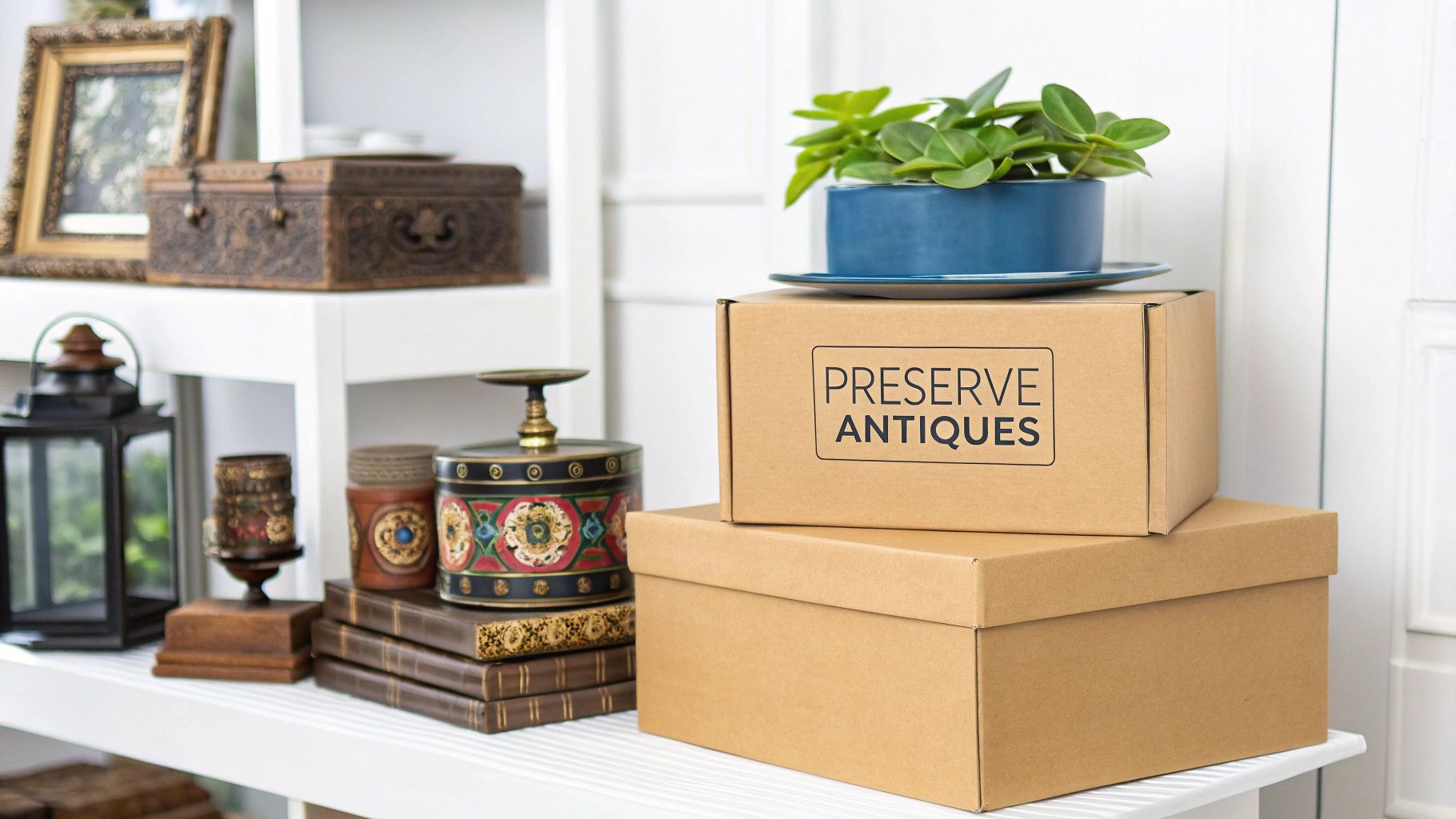
As you start exploring the world of antiques, you're going to have questions. It’s just part of the journey, whether you're a seasoned collector or just curious about a box of old family heirlooms. Getting good answers is what builds your confidence and helps you make smarter decisions.
Think of this section as your personal FAQ. I’ll walk you through some of the most common questions I hear, from how much an appraisal costs to whether you should ever restore a piece. Let's clear up the confusion so you can get back to the thrill of discovery.
How Much Does a Professional Appraisal Cost?
This is usually the first thing people want to know, and the honest answer is: it varies. The cost of a professional appraisal really depends on the appraiser's experience, their specialty, and how complex your item is.
Most certified appraisers charge an hourly rate, which can range anywhere from $150 to $400 an hour. Some might offer a flat fee for a single, straightforward item, while a large collection could be priced as a whole project. That fee covers their time for hands-on examination, deep-dive research, and preparing the formal report.
An Ethical Red Flag: Be very wary of any appraiser who wants to charge a percentage of the antique's value. This is a massive conflict of interest, as it incentivizes them to inflate the price. Reputable professionals will always charge a flat or hourly rate that has nothing to do with what your item is worth.
Should I Restore an Antique Before Selling It?
In almost every situation, the answer is a firm no. This is one of the biggest mistakes newcomers make—they think that a shiny, "like-new" finish will fetch a higher price. The opposite is almost always true.
Collectors and serious buyers prize original condition above all else. That layer of dust, the gentle fading, and even the minor dings from a century of use are what we call patina. It's the physical evidence of an item's history, and stripping it away can absolutely tank its value. A clumsy, amateur restoration is even worse and can cause damage that can't be undone.
The best move? Get the item appraised just as it is. A professional can tell you if a high-end, expert restoration might be a worthwhile investment (which is rare) or if leaving it alone is the smarter financial play.
What Is the Difference Between Value Types?
You'll quickly learn that not all "values" are created equal. The number an appraiser gives you is entirely dependent on the purpose of the appraisal. Understanding these key differences is critical.
- Fair Market Value (FMV): This is what most people think of as "value." It’s the price an item would likely sell for on the open market between a knowledgeable buyer and a willing seller, with neither person being under pressure. This is the figure you'll see used for most sales and estate settlements.
- Insurance Value (Replacement Value): This number is almost always higher than the FMV. It represents the full retail cost to replace your exact item with a similar one of comparable age and quality from a specialized dealer. It accounts for things like dealer markup and the time it takes to find another one.
Knowing what you need is the first step. Are you planning to sell, or do you need to add the item to your homeowner's insurance? Tell your appraiser your goal upfront so they can give you the right kind of valuation.
Can I Trust an Online Appraisal?
Online appraisals and identification apps have exploded in popularity. They offer a super convenient and affordable way to get a quick read on something. For an initial identification or a general sense of value, they are fantastic tools to get you started.
But they have their limits. For anything official—like getting an insurance rider for a high-value piece or for legal matters like dividing an estate—an in-person appraisal is non-negotiable. A professional needs to physically hold the object. There are just too many subtle details in the condition, materials, and craftsmanship that a photograph can't possibly capture.
Use online tools as your first step, but when it really counts, call in a pro.
Ready to take the guesswork out of your next find? The Curio app puts an antique expert right in your pocket. Snap a photo to instantly identify items, get historical context, and receive a value estimate. Start building your collection and uncovering hidden treasures today.
